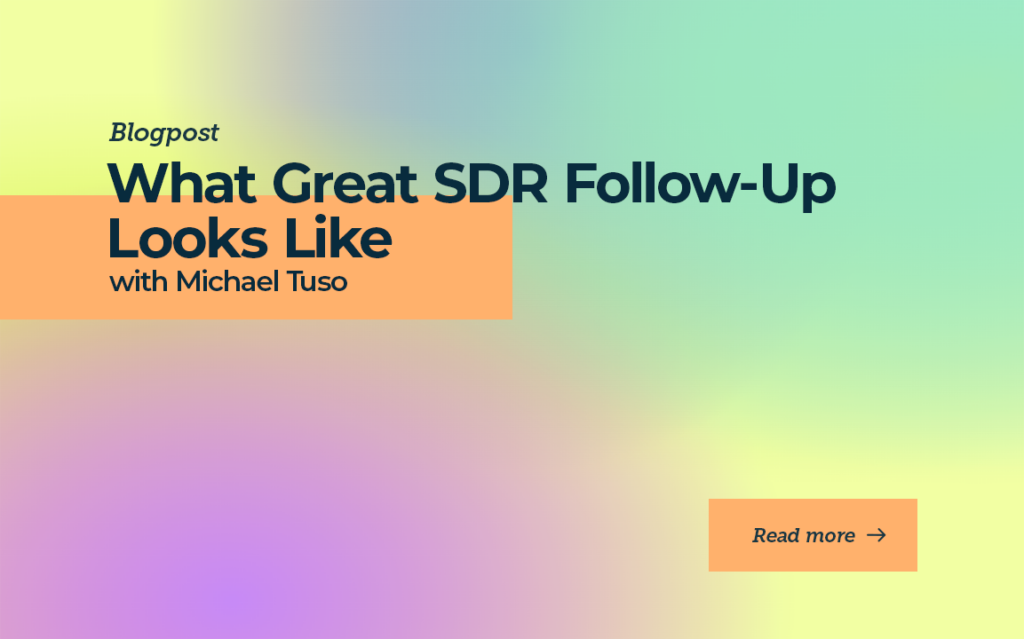What Great SDR Follow-Up Looks Like with Michael Tuso

The average response rate for cold emails is notoriously low, but sending a follow-up can increase your reply rate by 21%–and sending a second follow-up increases your chances even further.
Yet the vast majority of salespeople give up after just one attempt at outreach. Our latest podcast guest is determined to change that.
Michael Tuso is the Founder and CEO of Callypso, a revenue expansion and retention software for account managers. He joined the Predictable Revenue podcast to discuss what great follow-up looks like and tactical advice to become better at prospecting.
Why detailed note taking is crucial to follow-up
Cold calling (or cold emailing, for that matter), are not just ways to reach potential customers; they also hold a wealth of information that can help you close a deal successfully down the line.
When Michael started cold calling back in the day, he recalls going through the notes, and he’d always notice there was a lack of information and effort from the other 20 people that had cold called before him.
He then started taking notes of every bit of information he was able to collect throughout his follow-ups, things like what time the prospects were at the office or why they hadn’t moved forward with their company yet.
Eventually, Michael had collected so much information on these prospects that there were days he’d book a large number of opportunities, and the majority of them would come from those follow-ups.
The idea behind Michael’s micro-theory about reaching out to prospects and following up is to take advantage of the follow-ups to get basic information such as the prospect’s name or correct misinformation and grab the account and drive it as far as you can possibly go.
It is essential to nail the follow-up skill in a much more specific and dynamic way than your peers. This doesn’t guarantee that you will get the deal immediately, but getting more information than other people have before, can sometimes be the win in itself, that progression piece.
In the book Atomic Habits, a section says, for example, if you want to work out more, you can’t just say you want to work out more. You are much more likely to follow through with it if you specify things like: Where am I going to do it? When am I going to do it? Who am I doing it with?
Applying that level of specificity to your follow-ups and note-taking will take your productivity and quota to the next level.
Lastly, remember to be aware of where the prospect is on their buyer’s journey, not just where they are in your sales process. Most prospects won’t be in a buying motion when you reach out to them, but you should continue to nurture those people to stay top of mind.
The importance of qualification and different types of follow-up
Different prospects require different types of follow-up. For example, you should zone in on those interested now to progress them because they’re a hot lead, and now is the time to take action.
However, this doesn’t mean the rest of the leads or prospects should be forgotten. Instead, you should build separate outbound funnels for each based on their objection or where they are on their buyer’s journey.
For example:
- Interested now
Hot lead. They have shown interest in some way and should be prioritized.
- Interested but not ready
There are some obstacles standing in their way: other stakeholders in the company, internal processes, or budget. But just because they’re not ready now doesn’t mean they won’t be in the future.
Nurturing relationships and establishing a clear follow-up strategy are very important at this stage.
- Not interested
No positive engagement on their end. Reach out to them less often (every 6 months or so). Keep following up until they actively tell you to stop.
- Long-term nurturing
These are your closed lost opportunities. If they were the wrong person to make a deal with, an SDR could reach out to someone else at the same company. If it was a budget issue, they might enter the “interested but not ready” funnel.
Slow down the process. The goal should be less focused on ‘booking the meeting’ and more on engaging. The side effect is that you’re much more likely to get the prospects to book a meeting than if you’re just constantly throwing book-a-meeting CTAs to them all around.
If you move in this direction of getting people engaged, they will likely choose you and your solution when they are finally in the market.
Multi-threaded follow-up process
Multithreading is the process of targeting several prospects within one organization in order to build a use case in that company. It could be viewed as an extension of account-based marketing.
The whole idea of this is getting people to warm up to you, so they know who you are, what you’re about, and when they’re finally in the market and ready to buy, you’ll be top-of-mind.
This is a great technique to use when a prospect says no, and you’re not sure why; talking to other people in the organization can help you uncover the reason for that objection. If the company has the pain point your product solves, you can continue to follow up.
How SDRs can take advantage of multichannel prospecting
While most SDRs focus on email, cold calling, and LinkedIn, those aren’t the only ways to reach prospects. You can also meet them at in-person events, send gifts in the mail, leave a voicemail or send a text–the possibilities are endless.
Start by asking where your buyers are and where you can engage with them. If they use a certain social media platform, start building a presence there. The more channels you can spread your prospecting across, the better.
Multithreading and multichannel prospecting are tied hand in hand. It goes back to recognizing that as salespeople, you are drivers that make things happen.
An underrated tip for booking more calls
The mistake that many SDRs make is asking for a meeting too soon. Instead, try asking for a 5-minute call. Most people can find the time for a 5-minute conversation, and it’s much more reasonable than asking them to spend 30+ minutes on a demo.
Once you’re on a call with someone, qualifying them and sorting them into a specific follow-up funnel will be much easier. You can also skip straight to calling if they’re engaging with your emails but not responding.
For cold outreach, focus on “soft” asks (i.e., asking to send relevant content) rather than “hard” asks (to book a meeting). In our Outbound Labs series, soft asks had a much higher response rate.
How to take advantage of closed lost opportunities
Finally, look for ways to take advantage of closed-lost opportunities. Ask what happened for this lead to be lost and how you can correct it. In many cases, these opportunities were lost due to a lack of follow-up–which you can solve by re-engaging the prospect.
Final thoughts on the follow-up process
Learning to follow up and keep prospects engaged is a crucial skill all SDRs need to master. These tips on multithreading, building relationships, and taking advantage of every opportunity will help you focus on the most vital task–driving the deal forward.
If you need help with your prospecting or follow-up process, reach out here to learn how we can help with sequence design, pipeline management, and more.
If you want to connect with Michael to learn more about effective SDR prospecting and follow-up, reach out via LinkedIn.
NO TIME TO READ?
Listen On:



